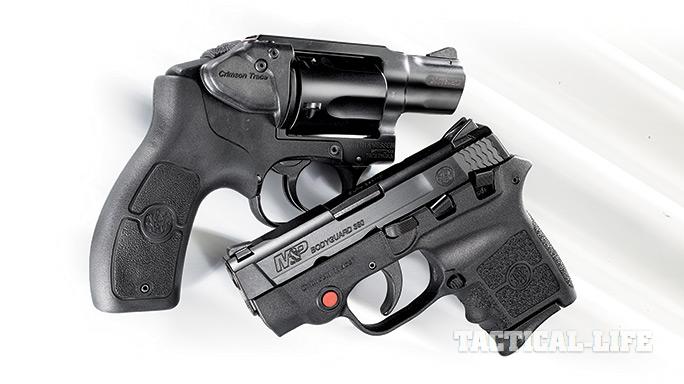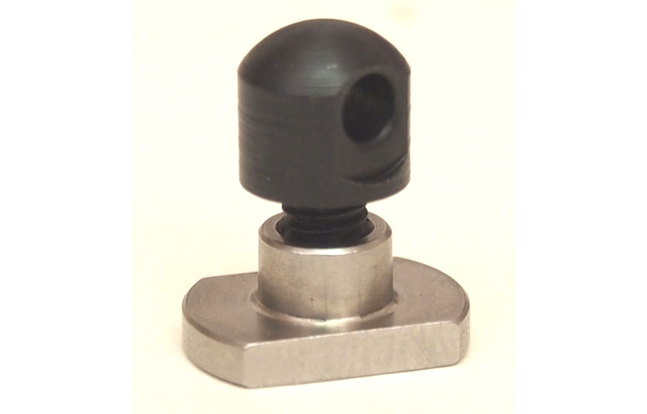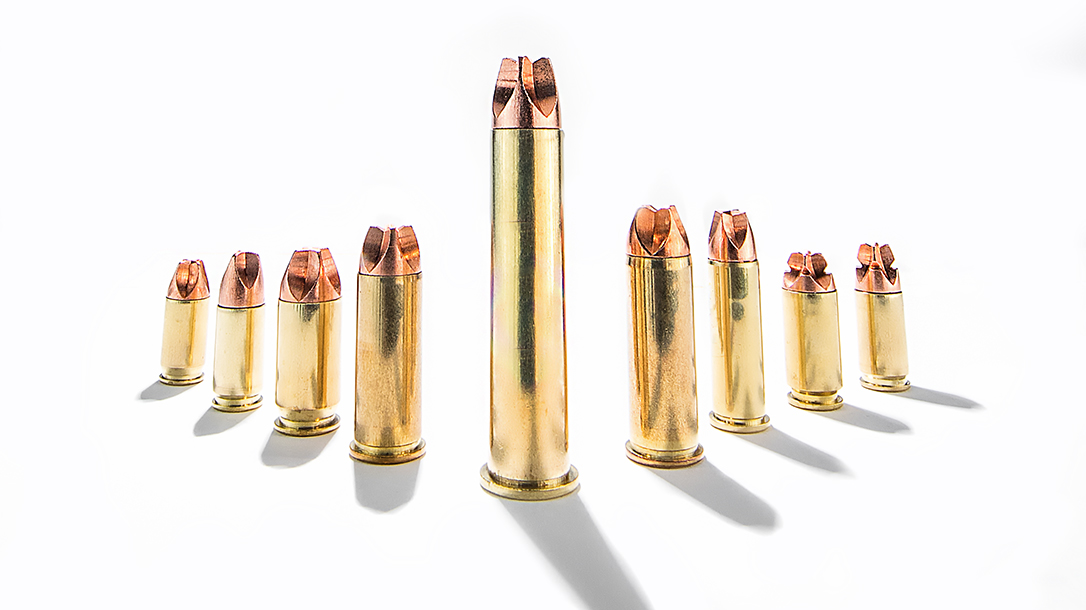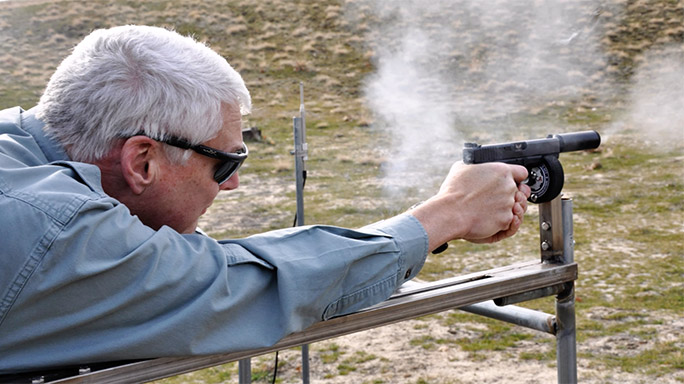When it comes to the topic of compact self-defense handguns, many gun enthusiasts think immediately of Smith & Wesson. With its extensive line of J-Frame revolvers and more recently compact autos, the company has been a major player in this category for decades. The introduction of the double-action-only (DAO), hammer-fired Bodyguard 38 and 380 handguns came about in 2010. S&W took the concept to the next level with cutting-edge design and materials as well as integrated laser units. The two handguns proved to be extremely popular with consumers. They tapped into the seemingly ever-growing market for concealable, powerful pocket guns.
Smith & Wesson has revamped and updated the line, adding the two pocket guns to its popular M&P series. The company describes these guns as being “engineered to professional standards.” The resulting guns—the M&P Bodyguard 38 revolver and M&P Bodyguard 380 auto—offer shooters a pair of pocket pistols ready for heavy duty use. They feature newly developed integrated Crimson Trace red laser units designed specifically for them.
Wheelgun Details
At their core, the M&P Bodyguards represent a melding of the traditional and the ultra-modern. Those who have carried or shot an S&W J-Frame snubbie will recognize the familiar general outline of the M&P Bodyguard 38 almost immediately. However, a closer look reveals more.
RELATED STORY: Reinventing the Wheel – 10 Elite Revolvers From Smith & Wesson
The five-shot, concealed-hammer, +P rated M&P Bodyguard 38 in .38 Special employs radically different materials and manufacturing techniques than its J-Frame siblings. Most notable in the design is the use of a stainless-steel-reinforced polymer “lower frame assembly” made up of the grip frame and triggerguard. This assembly design offers the dual benefits of lighter weight and overall lower cost.
The lower frame interfaces with an aluminum “upper frame.” This houses the fire control parts as well as surrounds the stainless steel, PVD-coated, five-shot cylinder. A barrel/ejector rod shroud is integrated into this frame as well, with a stainless steel 1.9-inch barrel insert that fits inside of it. All these lightweight materials result in an overall empty weight of just over 14 ounces.
In addition to different materials, the M&P Bodyguard 38 also features different operation. Most notably, the revolver’s polymer cylinder release lever is ambidextrous and located on the upper backstrap of the revolver. This requires a simple push forward to release the cylinder out of the left side of the frame. Just to the right of this is the polymer Crimson Trace laser module (which is removable), housing the integrated red laser. A small button on the top of the module controls the unit. One push turns the laser on, a second push puts it on “pulse” mode and a third push turns it off.
Also of note on the Bodyguard 38 is the fact that the cylinder rotates clockwise, rather than counter-clockwise like its contemporary S&W brethren. Sights on the revolver consist of a ramped front sight and a simple channel groove in the topstrap. An evenly applied black finish mates up with the matte-black polymer. This results in a very low-key and easy-to-conceal handgun.
Auto Alternative
The M&P Bodyguard 380, sibling to the M&P Bodyguard 38, taps into the popular ultra-compact .380 pistol market. The gun accomplishes its minute dimensions through the use of a locked-breech system. The hammer-fired 6+1 pistol weighs just over 12 ounces empty. It measures 5.25 inches in overall length with a 2.75-inch, stainless steel barrel housed within its blackened slide.
RELATED STORY: M&P Family – 5 Sentinels From Smith & Wesson
The heart of the pistol is its polymer frame, which houses an aluminum chassis containing the fire control mechanism of the gun. Located inside the dustcover portion of the polymer frame is an integrated Crimson Trace laser unit. The exposed forward lens is located directly under the muzzle of the pistol’s barrel. Like the Bodyguard 38, this red laser unit is modular and fully removable.
The laser unit of the M&P Bodyguard 380 is completely ambidextrous. Two buttons are located on either side of the frame just above and forward of the generously sized triggerguard. As with the M&P Bodyguard 38, one touch turns it on, a second puts it on “pulse” mode and a third turns it off. Of note is the fact that the new Crimson Trace laser system’s buttons on the 380 are colored red and feature more positive operation. In addition, there is a protective, raised ring around the buttons to help prevent inadvertent activation.
RELATED STORY: Gun Test – Smith & Wesson’s M&P9 VTAC Handgun
The controls of the M&P Bodyguard 380 are simple and straightforward, but not fully ambidextrous. A small, flat manual safety is located at the rear portion of the left side of the polymer frame. Just forward of it is a matching slide release lever, which locks open on an empty magazine. Forward of that is a takedown lever for disassembly. The pistol’s magazine release is located just behind the triggerguard.
The slide is topped off with a nice set of drift-adjustable front and rear sights, with the front sight being a ramped unit mating up to the notch rear unit. There are no dots or markings on the sights. A simple loaded-chamber indicator is made up of a hole cut in the rear of the barrel hood that allows visual access to a round in the chamber. The six-round magazine is made of stainless steel and features an orange follower. It comes equipped with a finger-groove extension floorplate. A spare low-profile flush floorplate magazine is also included with the pistol.
Range Results
Over the course of two days, I had the opportunity to test-fire the guns as well as run them through a low-light, IDPA-style course. Both guns performed well, with the lasers helping me to engage the targets quickly and accurately.
I took the two models to a local range and put them both through more functioning tests as well as some formal accuracy testing at 7 yards. I used a selection of Federal, Remington and Speer loads. As they did in Springfield, both guns performed well with no malfunctions. I did note that due to their small size and light weights, extended shooting sessions did become a bit of a chore. Considering their DAO triggers and intended purposes, I also found them to be extremely accurate. See the accompanying chart for the specific results with each gun.
Parting Shots
The new M&P Bodyguard 38 and 380 handguns, and their new Crimson Trace laser systems, make for a very appealing combination for anyone looking for a new snubbie revolver or deep-cover .380 for self-defense use. With their rugged construction, capable chamberings, useful laser systems and light weights, either one of these should make for a good choice for CCW use.
For more information, visit https://www.smith-wesson.com or call 800-331-0852.






































